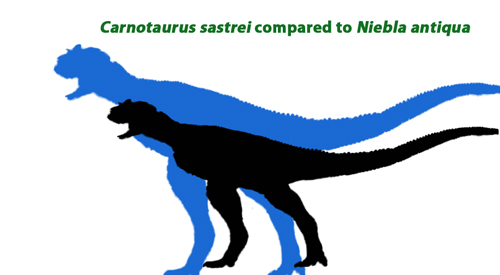Niebla antiqua – A New Dinosaur Species
A New Medium-sized Abelisaurid – Niebla antiqua
A new species of Late Cretaceous abelisaurid theropod has been named based on fragmentary fossils found in northern Patagonia (Argentina). The dinosaur has been named Niebla antiqua and it represents one of the most derived of all the abelisaurids described to date. With an estimated body length of around 4 to 4.5 metres, Niebla is smaller than the roughly contemporaneous abelisaurid Quilmesaurus (Q. curriei), known from the same formation and considerably smaller than Carnotaurus sastrei.
Niebla antiqua
Described recently in a scientific paper published in the Journal of South American Earth Sciences, the description being based on ribs, weathered vertebrae, a near complete braincase, lower jaw fragments (dentary) and teeth plus a relatively intact scapulocoracoid (pectoral girdle), Niebla helps to strengthen the fossil record of abelisaurids known from the Maastrichtian.
The Location of the Niebla antiqua Fossil Discovery in Río Negro Province (Patagonia) and a Skeletal Drawing

Picture credit: Rolando et al (Journal of South American Earth Sciences)
The fossil material was found during excavation of exposed Allen Formation strata located near Matadero Hill in the province of Río Negro by CONICET researchers. Their study suggests that abelisaurid evolution may be more complex than previously thought.
A Size Comparison Between Niebla antiqua and Carnotaurus sastrei

Picture credit: Everything Dinosaur
Adding to the Diversity of South American Members of the Abelisauridae
Abelisauridae dinosaurs are very well known from South America. However, the fossil record of the very youngest members of this theropod family (abelisaurids associated with the Maastrichtian faunal stage of the Late Cretaceous), is relatively poor. The researchers describe a new species (Niebla antiqua), although the fossils are highly fragmentary, they conclude that the material represents an adult animal and therefore this dinosaur was a medium-sized abelisaurid, much smaller than other coeval abelisaurids such as Carnotaurus and Abelisaurus.
The genus name is from the Spanish for “mist” a reference to the foggy conditions that the field team encountered when conducting the excavation, whilst the trivial or specific name refers to the great age of the strata.
A Medium-sized Abelisaurid
The braincase shows autapomorphic features (unique characteristics), such as a dorsoventrally tall basal tuber and postemporal foramen enclosed by parietal and exoccipitals. The scapulocoracoid is notably similar to that of Carnotaurus (C. sastrei), the research team note a number of features including having a posterodorsally oriented glenoid, a dorsoventrally expanded and wide coraco-scapular plate and the blade of the scapula is very narrow and straight. These anatomical traits are very different from those of other abelisaurids. This might indicate a unique conformation of the pectoral girdle among these South American members of the Theropoda.
The scientific paper: “A new medium-sized abelisaurid (Theropoda, Dinosauria) from the late cretaceous (Maastrichtian) Allen Formation of Northern Patagonia, Argentina” by Mauro Aranciaga Rolando, Mauricio A. Cerroni, Jordi A. Garcia Marsà, Federico l. Agnolín, Matías J. Motta, Sebastián Rozadilla, Federico Brisson Eglí and Fernando E. Novas published in the Journal of South American Earth Sciences.
Visit the user-friendly Everything Dinosaur website: Everything Dinosaur.

